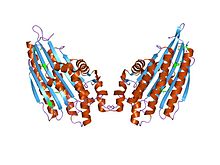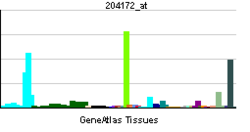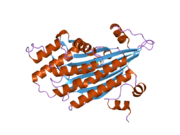- Coproporphyrinogen III oxidase
-
Coprogen_oxidas 
coproporphyrinogen iii oxidase from leishmania major Identifiers Symbol Coprogen_oxidas Pfam PF01218 InterPro IPR001260 PROSITE PDOC00783 Available protein structures: Pfam structures PDB RCSB PDB; PDBe PDBsum structure summary Coproporphyrinogen-III oxidase, mitochondrial is an enzyme that in humans is encoded by the CPOX gene.[1][2][3] A genetic defect in the enzyme results in a reduced production of heme in animals. The medical condition associated with this enzyme defect is called hereditary coproporphyria.[4] [5]
It is an enzyme involved in the sixth step of porphyrin metabolism it catalyses the oxidative decarboxylation of coproporphyrinogen III to proto-porphyrinogen IX in the haem and chlorophyll biosynthetic pathways.[2][6] The protein is a homodimer containing two internally bound iron atoms per molecule of native protein.[7] The enzyme is active in the presence of molecular oxygen that acts as an electron acceptor. The enzyme is widely distributed having been found in a variety of eukaryotic and prokaryotic sources.
References
- ^ Lamoril J, Martasek P, Deybach JC, Da Silva V, Grandchamp B, Nordmann Y (Jun 1995). "A molecular defect in coproporphyrinogen oxidase gene causing harderoporphyria, a variant form of hereditary coproporphyria". Hum Mol Genet 4 (2): 275–8. doi:10.1093/hmg/4.2.275. PMID 7757079.
- ^ a b Kohno H, Furukawa T, Yoshinaga T, Tokunaga R, Taketani S (Nov 1993). "Coproporphyrinogen oxidase. Purification, molecular cloning, and induction of mRNA during erythroid differentiation". J Biol Chem 268 (28): 21359–63. PMID 8407975.
- ^ "Entrez Gene: CPOX coproporphyrinogen oxidase". http://www.ncbi.nlm.nih.gov/sites/entrez?Db=gene&Cmd=ShowDetailView&TermToSearch=1371.
- ^ "Hereditary coproporphyria". Genetic and Rare Diseases Information Center. National Institutes of Health. http://rarediseases.info.nih.gov/GARD/Condition/6619/Coproporphyria.aspx. Retrieved 8 August 2011.
- ^ "CPOX". Genetics Home Reference. http://ghr.nlm.nih.gov/gene/CPOX. Retrieved 8 August 2011.
- ^ Madsen O, Sandal L, Sandal NN, Marcker KA (October 1993). "A soybean coproporphyrinogen oxidase gene is highly expressed in root nodules". Plant Mol. Biol. 23 (1): 35–43. doi:10.1007/BF00021417. PMID 8219054.
- ^ Camadro JM, Chambon H, Jolles J, Labbe P (May 1986). "Purification and properties of coproporphyrinogen oxidase from the yeast Saccharomyces cerevisiae". Eur. J. Biochem. 156 (3): 579–87. doi:10.1111/j.1432-1033.1986.tb09617.x. PMID 3516695.
Further reading
- Fujita H, Kondo M, Taketani S et al. (1995). "Characterization and expression of cDNA encoding coproporphyrinogen oxidase from a patient with hereditary coproporphyria". Hum. Mol. Genet. 3 (10): 1807–10. doi:10.1093/hmg/3.10.1807. PMID 7849704.
- Cacheux V, Martasek P, Fougerousse F et al. (1994). "Localization of the human coproporphyrinogen oxidase gene to chromosome band 3q12". Hum. Genet. 94 (5): 557–9. doi:10.1007/BF00211026. PMID 7959694.
- Delfau-Larue MH, Martasek P, Grandchamp B (1995). "Coproporphyrinogen oxidase: gene organization and description of a mutation leading to exon 6 skipping". Hum. Mol. Genet. 3 (8): 1325–30. doi:10.1093/hmg/3.8.1325. PMID 7987309.
- Martasek P, Nordmann Y, Grandchamp B (1994). "Homozygous hereditary coproporphyria caused by an arginine to tryptophane substitution in coproporphyrinogen oxidase and common intragenic polymorphisms". Hum. Mol. Genet. 3 (3): 477–80. doi:10.1093/hmg/3.3.477. PMID 8012360.
- Maruyama K, Sugano S (1994). "Oligo-capping: a simple method to replace the cap structure of eukaryotic mRNAs with oligoribonucleotides". Gene 138 (1–2): 171–4. doi:10.1016/0378-1119(94)90802-8. PMID 8125298.
- Martasek P, Camadro JM, Delfau-Larue MH et al. (1994). "Molecular cloning, sequencing, and functional expression of a cDNA encoding human coproporphyrinogen oxidase". Proc. Natl. Acad. Sci. U.S.A. 91 (8): 3024–8. doi:10.1073/pnas.91.8.3024. PMC 43507. PMID 8159699. http://www.pubmedcentral.nih.gov/articlerender.fcgi?tool=pmcentrez&artid=43507.
- Taketani S, Kohno H, Furukawa T et al. (1994). "Molecular cloning, sequencing and expression of cDNA encoding human coproporphyrinogen oxidase". Biochim. Biophys. Acta 1183 (3): 547–9. doi:10.1016/0005-2728(94)90083-3. PMID 8286403.
- Lamoril J, Deybach JC, Puy H et al. (1997). "Three novel mutations in the coproporphyrinogen oxidase gene". Hum. Mutat. 9 (1): 78–80. doi:10.1002/(SICI)1098-1004(1997)9:1<78::AID-HUMU17>3.0.CO;2-M. PMID 8990017.
- Daimon M, Gojyou E, Sugawara M et al. (1997). "A novel missense mutation in exon 4 of the human coproporphyrinogen oxidase gene in two patients with hereditary coproporphyria". Hum. Genet. 99 (2): 199–201. doi:10.1007/s004390050338. PMID 9048920.
- Schreiber WE, Zhang X, Senz J, Jamani A (1997). "Hereditary coproporphyria: exon screening by heteroduplex analysis detects three novel mutations in the coproporphyrinogen oxidase gene". Hum. Mutat. 10 (3): 196–200. doi:10.1002/(SICI)1098-1004(1997)10:3<196::AID-HUMU3>3.0.CO;2-H. PMID 9298818.
- Suzuki Y, Yoshitomo-Nakagawa K, Maruyama K et al. (1997). "Construction and characterization of a full length-enriched and a 5'-end-enriched cDNA library". Gene 200 (1–2): 149–56. doi:10.1016/S0378-1119(97)00411-3. PMID 9373149.
- Lamoril J, Puy H, Gouya L et al. (1998). "Neonatal hemolytic anemia due to inherited harderoporphyria: clinical characteristics and molecular basis". Blood 91 (4): 1453–7. PMID 9454777.
- Susa S, Daimon M, Kondo H et al. (1999). "Identification of a novel mutation of the CPO gene in a Japanese hereditary coproporphyria family". Am. J. Med. Genet. 80 (3): 204–6. doi:10.1002/(SICI)1096-8628(19981116)80:3<204::AID-AJMG4>3.0.CO;2-G. PMID 9843038.
- Rosipal R, Lamoril J, Puy H et al. (1999). "Systematic analysis of coproporphyrinogen oxidase gene defects in hereditary coproporphyria and mutation update". Hum. Mutat. 13 (1): 44–53. doi:10.1002/(SICI)1098-1004(1999)13:1<44::AID-HUMU5>3.0.CO;2-Q. PMID 9888388.
- Taketani S, Furukawa T, Furuyama K (2001). "Expression of coproporphyrinogen oxidase and synthesis of hemoglobin in human erythroleukemia K562 cells". Eur. J. Biochem. 268 (6): 1705–11. doi:10.1046/j.1432-1327.2001.02045.x. PMID 11248690.
- Lamoril J, Puy H, Whatley SD et al. (2001). "Characterization of Mutations in the CPO Gene in British Patients Demonstrates Absence of Genotype-Phenotype Correlation and Identifies Relationship between Hereditary Coproporphyria and Harderoporphyria". Am. J. Hum. Genet. 68 (5): 1130–8. doi:10.1086/320118. PMC 1226094. PMID 11309681. http://www.pubmedcentral.nih.gov/articlerender.fcgi?tool=pmcentrez&artid=1226094.
- Elkon H, Don J, Melamed E et al. (2003). "Mutant and wild-type alpha-synuclein interact with mitochondrial cytochrome C oxidase". J. Mol. Neurosci. 18 (3): 229–38. doi:10.1385/JMN:18:3:229. PMID 12059041.
- Wiman A, Floderus Y, Harper P (2002). "Two novel mutations and coexistence of the 991C>T and the 1339C>T mutation on a single allele in the coproporphyrinogen oxidase gene in Swedish patients with hereditary coproporphyria". J. Hum. Genet. 47 (8): 407–12. doi:10.1007/s100380200059. PMID 12181641.
PDB gallery  Heme synthesis—note that some reactions occur in the cytoplasm and some in the mitochondrion (yellow)
Heme synthesis—note that some reactions occur in the cytoplasm and some in the mitochondrion (yellow)External links
Porphyrin biosynthesis early mitochondrial: Aminolevulinic acid synthase (ALAS1, ALAS2) · Porphobilinogen synthase
cytosolic: Porphobilinogen deaminase · Uroporphyrinogen III synthase · Uroporphyrinogen III decarboxylase · Coproporphyrinogen III oxidase
late mitochondrial: Protoporphyrinogen oxidase · FerrochelataseHeme degradation
to bilespleen: Heme oxygenase · Biliverdin reductase
liver: glucuronosyltransferase (UGT1A1)
This article includes text from the public domain Pfam and InterPro IPR001260Categories:- Human proteins
- Oxidoreductase stubs
- Protein families
Wikimedia Foundation. 2010.



